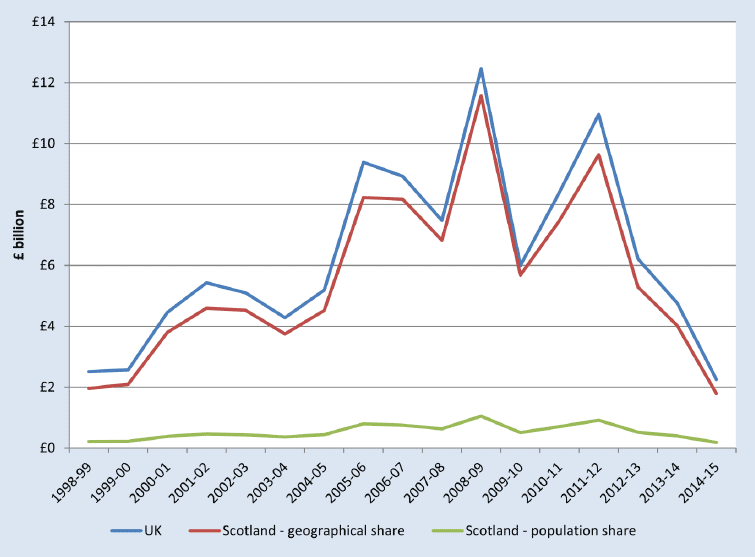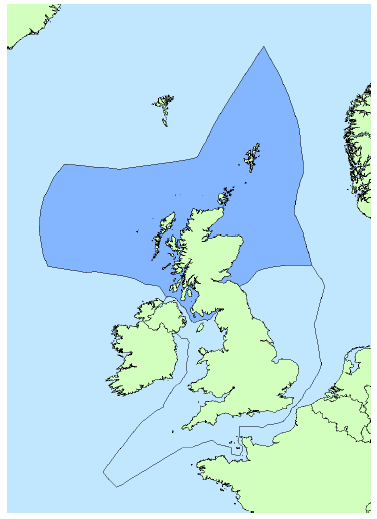Government Expenditure & Revenue Scotland 2014-15
Government Expenditure and Revenue Scotland (GERS) is a National Statistics publication. It estimates the contribution of revenue raised in Scotland toward the goods and services provided for the benefit of Scotland. The estimates in this publication are consistent with the UK Public Sector Finances published in January 2016.
Chapter 2: North Sea Revenue
North Sea Revenue: 1998-99 to 2014-15

North Sea revenue in GERS comes from four sources: petroleum revenue tax, corporation tax, licence fees, and the emissions trading scheme.
Table 2.1 shows the levels of revenue raised from each component of North Sea revenue since 2010-11. UK North Sea revenue was £8.4 billion in 2010-11 and reached £11.0 billion in 2011-12, but has been declining since, due to declining production, rising expenditure, and, in 2014-15, falling oil prices.
North Sea revenue is subject to annual fluctuations and is driven by a number of factors, including the oil price, the sterling dollar exchange rate, production, operating expenditure, capital investment, and the prevailing fiscal regime. Most of these factors have been acting to reduce revenue in recent years. In 2014-15, production remained broadly flat compared to 2013-14, but operating costs rose approximately 9% and capital investment remained at historic highs. Prices began to fall in the second half of 2014, from a peak of $110 a barrel in June 2015 to $58 a barrel in the first half of 2015. Finally, the supplementary charge on companies' ring fenced profits was reduced from 32% to 20% from January 2015.
Estimates of the share of UK emissions trading scheme revenue arising in the North Sea are produced by the Scottish Government based on UK permit data received from the Scottish Environment Protection Agency.
Table 2.1: Composition of North Sea Revenue: UK 2010-11 to 2014-15
| (£ million) | |||||
|---|---|---|---|---|---|
| 2010-11 | 2011-12 | 2012-13 | 2013-14 | 2014-15 | |
| Licence fees | 69 | 67 | 69 | 71 | 72 |
| North Sea corporation tax | 6,864 | 8,840 | 4,393 | 3,556 | 2,073 |
| Petroleum revenue tax | 1,458 | 2,032 | 1,737 | 1,118 | 77 |
| Emissions trading scheme revenues | 11 | 18 | 16 | 19 | 32 |
| Total | 8,402 | 10,957 | 6,215 | 4,764 | 2,254 |
Scotland's Share of North Sea Revenue
In the ONS Regional Accounts, the UK Continental Shelf (UKCS) is included as a separate region of the UK (the extra-regio territory) and not allocated to specific geographic regions within the UK mainland. As such, an assumption as to Scotland's share of the North Sea needs to be made in GERS.
Three estimates of Scotland's share of North Sea revenue are adopted in the GERS report:
1. Zero share
2. A population share
3. An illustrative geographical share
As the situation under option 1 is the same as the revenue estimates for all non-North Sea revenues, the discussion below focuses on population and geographical shares.
Population Share
One interpretation of North Sea revenue is to view it as a non-identifiable UK revenue, in which case a population share may be apportioned to Scotland. Table 2.2 provides an estimate of Scotland's share of North Sea revenue under this approach.
Table 2.2: Population Share of North Sea Revenue: Scotland
| (£ million) | |||||
|---|---|---|---|---|---|
| 2010-11 | 2011-12 | 2012-13 | 2013-14 | 2014-15 | |
| Total North Sea revenue | 5,991 | 8,406 | 10,958 | 6,214 | 4,766 |
| Scotland's population share | 704 | 917 | 518 | 395 | 187 |
| Scotland's share of North Sea revenue (%) | 8.4% | 8.4% | 8.3% | 8.3% | 8.3% |
An Illustrative Geographical Share
An alternative approach is to apportion a geographical share of North Sea revenue to Scotland. In order to estimate this share, GERS draws upon academic research carried out by Professor Alex Kemp and Linda Stephen from the University of Aberdeen. Professor Kemp is Professor of Petroleum Economics and Director of Aberdeen Centre for Research in Energy Economics and Finance (ACREEF) at the University of Aberdeen. Professor Kemp and Linda Stephen have published extensively on licensing and taxation issues on the UK Continental Shelf (UKCS). Professor Kemp is the author of "The Official History of North Sea Oil and Gas", and is considered to be a leading expert in UK petroleum economics.
The model used by the researchers to estimate Scotland's illustrative geographical share of North Sea activity was first detailed in a North Sea Study Occasional paper published by the University of Aberdeen in 1999.[14] The researchers base the Scottish boundary of the UKCS on the median line principle as employed in 1999 to determine the boundary between Scotland and the rest of the UK for fishery demarcation purposes. Other alternatives are possible. UKCS production, costs and revenue is allocated on a field by field basis to either the rest of the UK or Scotland using this boundary.
Further detail on the methodology used to estimate Scotland's illustrative geographical share of North Sea receipts is available at: http://www.gov.scot/Topics/Statistics/Browse/Economy/GERS/Methodology
Table 2.3 shows Scotland's illustrative geographical share of UK North Sea revenue. The share fell in 2014-15, despite Scotland's share of total hydrocarbon production staying broadly constant. This is because the increase in UKCS capital expenditure was concentrated within the Scottish share of the North Sea. This higher level of investment reduces the estimated share of Scottish tax liabilities.
Table 2.3: Geographical Share of North Sea Revenue: Scotland 2010-11 to 2014-15
| (£ million) | |||||
|---|---|---|---|---|---|
| 2010-11 | 2011-12 | 2012-13 | 2013-14 | 2014-15 | |
| Total North Sea revenue | 8,402 | 10,957 | 6,215 | 4,764 | 2,254 |
| Scotland's geographical share | 7,466 | 9,633 | 5,289 | 3,999 | 1,804 |
| Scotland's percentage share of North Sea revenue | 88.9% | 87.9% | 85.1% | 84.0% | 80.0% |
Scotland's estimated geographical share of the North Sea sector, used in this report, is highlighted in the figure below. Demarcation by the median line is highlighted by the dark shaded area.
UK Continental Shelf and Scottish Boundary

Source: Scottish Government Marine Directorate
Contact
Email: Mairi Spowage
There is a problem
Thanks for your feedback